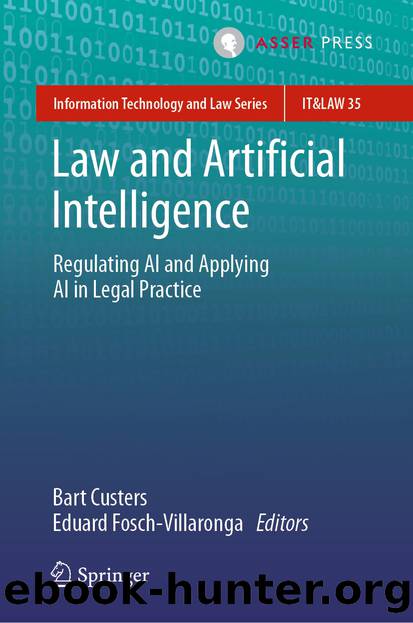Law and Artificial Intelligence: Regulating AI and Applying AI in Legal Practice by Bart Custers & Eduard Fosch-Villaronga

Author:Bart Custers & Eduard Fosch-Villaronga
Language: eng
Format: epub
ISBN: 9789462655232
Publisher: T.M.C. Asser Press
15.3.2 The Causation Turbulence
The element of causation is indispensable for a proper understanding of the concept of liability. It is the ability to distinguish an injury from a misfortune and to isolate the accountable actor(s) from the multitude of events/actions leading to the injury/harm.33 In the medical context many professionals and devices play an important part in the treatment and care of patients. Causation is therefore an important instrument with which to find the accountable actor(s). If causation cannot be proven, then the accountability gap widens, and the liability framework produces legal as well as economic failure.
The literature explains the likelihood for failure by using two concurring elements: Control and foreseeability.34 For example, the producer of a medical device is assumed to be in control of the manufacturing process, as well as to be able to reasonably foresee all the uses of the device and the expectations of the users (doctor, nurse, laboratory analyst etc.). When the producer can prove that a defect was not reasonably foreseeable,35 or that the defect occurred due to circumstances out of his control,36 the producer may escape liability, because there is no causal link between the harm and the product defect. Therefore, any liability regime must keep a keen eye on control and foreseeability of damages.
The concept of control plays an important role in the proposal. It is one of the elements used to define the operator.37 Recital 10 explains that the rationale of the proposal is based on the fact that the operator exercises a degree of control over the AI-system, comparable to the control that an owner has over its car. However, there appears to be a contradiction between Recital 10 and Article 3, as the latter defines control as any action that influences the operation of an AI-system. Perceiving control as any action of influence is a lower standard than the control normally required under strict liability. Therefore, it is unclear which version of control the proposal assumes to exist with operators over AI-systems. Is it âany influenceâ or the standard level of control?
Both versions of control are problematic. Firstly, if we consider that the standard of control can be lowered to equate influence, then we can support the conclusion that operators are in control over the performance of the AI-systems. They can substantially influence the learning process, the data sets that are fed, and the environment where the AI-system will be deployed.38 However, such an interpretation of control is incompatible with the concept of control that currently justifies the strict liability rationale. Producers are not able to merely âinfluenceâ the manufacturing process, but they must control it to such a degree that they get the desired output. The driver of a (non-autonomous) vehicle is not âinfluencingâ but controls every move of the vehicle. To put it briefly, if one accepts that the operatorâs degree of control over an AI-system is on a level of influencing the system, and not being in control of its performance, the rationale for strict liability of such operators fails its doctrinal requirements.
Download
This site does not store any files on its server. We only index and link to content provided by other sites. Please contact the content providers to delete copyright contents if any and email us, we'll remove relevant links or contents immediately.
Practical Guide to Azure Cognitive Services by Chris Seferlis & Christopher Nellis & Andy Roberts(7103)
Unity Artificial Intelligence Programming - Fifth Edition by Dr. Davide Aversa(6716)
Serverless ETL and Analytics with AWS Glue by Vishal Pathak Subramanya Vajiraya Noritaka Sekiyama Tomohiro Tanaka Albert Quiroga Ishan Gaur(5311)
Open Source Projects - Beyond Code by John Mertic(4376)
Graph Data Modeling in Python by Gary Hutson and Matt Jackson(4358)
The AI Product Manager's Handbook by Irene Bratsis(4346)
Cloud Auditing Best Practices by Shinesa Cambric & Michael Ratemo(3997)
Aligning Security Operations with the MITRE ATT&CK Framework by Rebecca Blair(3992)
Graph Data Processing with Cypher by Anthapu Ravindranatha;(2148)
Data Literacy in Practice - A complete guide to data literacy and making smarter decisions with data through intelligent actions (2022) by Packt(2147)
Serverless Machine Learning with Amazon Redshift ML: Create, train, and deploy machine learning models using familiar SQL commands by Debu Panda Phil Bates Bhanu Pittampally Sumeet Joshi(2016)
Network Automation with Go by Nicolas Leiva & Michael Kashin(1965)
Unreal Engine 5 Game Development with C++ Scripting by Zhenyu George Li(1772)
Implementing Multifactor Authentication: Protect your applications from cyberattacks with the help of MFA by Marco Fanti(1629)
Applied Machine Learning and High-Performance Computing on AWS by Mani Khanuja | Farooq Sabir | Shreyas Subramanian | Trenton Potgieter(1366)
Data Literacy in Practice by Angelika Klidas Kevin Hanegan(1355)
Graph Data Processing with Cypher by Ravindranatha Anthapu(1332)
Fuzzing Against the Machine: Automate vulnerability research with emulated IoT devices on QEMU by Antonio Nappa Eduardo Blazquez(1207)
The AI Product Manager's Handbook: Develop a product that takes advantage of machine learning to solve AI problems by Irene Bratsis(1056)
